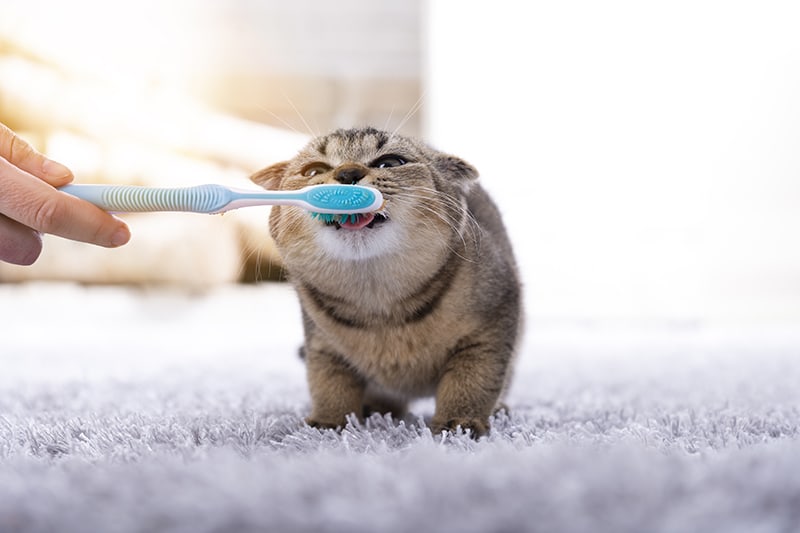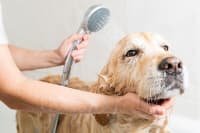Pet Care
A Pet Parent’s Guide to Cat Dental Care
Cat Dental Health
Cats are naturally adept at hiding when they are in pain. Your kitty may be suffering from a painful oral health issue without ever letting on that they are uncomfortable. Because of this, it’s important for pet parents to be conscious of their feline companion’s oral health and keep their cat’s teeth clean. By monitoring and regularly cleaning your cat’s teeth, you will be able to detect any oral health issues early and help your cat avoid pain and expensive treatment.
How To Clean Your Cat’s Teeth
Maintaining a daily dental hygiene routine for your cat could help to keep your feline friend’s teeth and gums healthy throughout their lifetime. To make cleaning your cat’s teeth at home as easy and stress-free as possible, begin establishing a daily oral hygiene routine for your cat while they are still a kitten. This way, your cat will be accustomed to having their teeth brushed and mouth touched from a young age.
Strive to make brushing your cat’s teeth a stress-free and easy part of your kitty’s daily routine. Start by waiting until your cat is calm and relaxed, then follow these steps:
- Gently lift your cat’s lips, then use your finger to massage their teeth and gums for just a few seconds.
- Don’t expect too much from your cat at first. You may only be able to reach a couple of teeth the first few times your try this process. That’s okay though. This is about building trust in your cat to help prevent them from becoming agitated.
- Remain calm and be sure to give lots of praise and a yummy treat after your teeth-and-gum massage. You’re trying to build your cat’s tolerance to the experience, gradually increasing the length of time you spend on the task each day.
- Once your feline friend is used to you massaging their gums each day, you will be able to gradually introduce a soft-bristled toothbrush you can acquire from you vet and some special cat toothpaste. Toothpaste can come in a range of excellent flavors for cats like beef or chicken.
- Begin using the toothbrush as gradually as you did the teeth-and-gum massage; your cat may begin with licking just a small dab of toothpaste from your finger.
Introduce Toothbrushing Slowly
The level of success you achieve when it comes to cleaning your cat’s teeth will largely depend on your pet’s temperament. Make sure you are calm, relaxed, flexible and willing to adapt your approach to your cat’s level of tolerance. Many cat owners have a very easy time cleaning their pet’s teeth with some gauze, others find a finger brush works well and others apply a dental gell with their fingers that they allow to do the work for them.
When you finally begin brushing your cat’s teeth successfully, move along the gum line, working quickly but stopping before your cat becomes irritated. It could be weeks before your kitty tolerates having all of their teeth cleaned during a single session.
If your kitty is stressed or alarmed by the teeth cleaning process they may react by scratching or biting. So if brushing your cat’s teeth is too difficult for you and your kitty consider adding plaque remover additives into their drinking water, getting them specially designed chew toys or providing your cat with tasty dental treats.
Routine Dental Exams For Cats
To help ensure that your cat’s mouth stays pain-free and healthy, our vets recommend annual professional dental care as a part of your kitty’s preventative healthcare routine. Taking your cat for a dental appointment is like a visit to the cat dentist. Your vet will evaluate your cat’s oral health, take x-rays if required, and do a thorough cleaning. If your cat is suffering from a mouth injury, tooth loss or severe decay, your dentist will provide you with recommendations regarding care or surgery to treat your cat’s oral health issues.
To find out more about dental care for cats available here at Animal Hospital of Clemmons in Clemmons animal hospital check out our dentistry page.
Note: The advice provided in this post is intended for informational purposes and does not constitute medical advice regarding pets. For an accurate diagnosis of your pet’s condition, please make an appointment with your vet.
Is it time to book a dental appointment for your feline friend? Contact Animal Hospital of Clemmons today to book an appointment for your beloved cat.
Looking for a vet in
Clemmons?
We’re always accepting new patients, so contact our veterinary hospital today to book your pet’s first appointment.
Related Articles View All
How to Tell if Your Cat Has a Broken Leg
Regardless of whether your cat is a curious outdoor explorer or a chilled-out homebody, accidents can happen. Today, our Clemmons vets share signs that may indicate that your cat has a broken leg, and what you should do.
Cat Coughing, Sneezing & Wheezing
Is your cat coughing, sneezing and wheezing instead of contentedly purring? Cat coughs are a sign that something is irritating your feline friend’s lungs, airway or throat. Today, our Clemmons vets share some common causes of cat coughs and what to do.
Signs of Pain in Cats & How to Help
To provide your cat with all the care they need to live a long and healthy life, it’s important to be able to spot the signs of pain early and know what to do. Below, our Clemmons vets offer some advice on how to tell if your cat is in pain, and what you can do to help.
My Cat is Sleeping Constantly: Is this Cause for Worry?
Cats, without a doubt, enjoy sleeping. Concerned cat owners frequently ask our Clemmons veterinarians if they should be concerned that their cat sleeps so much. When does a cat nap signal the possibility of a medical emergency?







